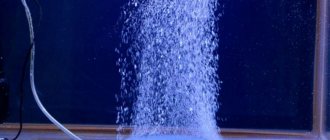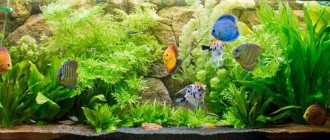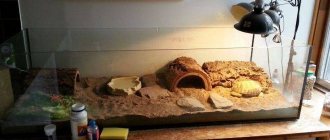Aquarium soil serves as the basis for the growth of aquatic plants, a decorative substrate and an important element of the internal biosphere. To provide comfortable conditions for fish (especially the whimsical tropical ones), it is necessary to take care of high water quality. One way to do this is to buy and place special aquarium soil . But how to choose it, what type of soil should you give preference to? This is what we will discuss in today’s article.
Soil for an aquarium – which one is better to choose?
Why do you need soil for an aquarium?
Beginning aquarists often underestimate the role of soil, naively believing that it is just one of the decorative elements. But you should know that an aquarium is a kind of imitation of a natural reservoir, and many processes take place here that are invisible to the human eye.
Aquarium soil is not only a decorative element
Why do you need soil in an aquarium at all? In addition to decorative, it also performs other functions:
- serves as a substrate in which the roots of aquatic plants are fixed;
- is a habitat for some fish and other organisms;
- plays a biological role.
The last point is worth considering in more detail. Good soil particles have a porous surface, which is gradually colonized by beneficial bacteria. The same thing happens with biological filter media. The excretions of the inhabitants of the aquarium, along with plant debris and food particles, settle to the bottom, where they begin to decompose, releasing toxic substances (such as ammonium and ammonia - they literally poison the water). Even constant water changes will not help with this! That is why a normal ecosystem in an aquarium is impossible without good soil.
Proper soil is the basis of an aquarium
Popular manufacturers
The best nutrient substrate for an aquarium with a large number of plants is considered to be ADA Power Sand Special. It contains nutrient granules made from porous volcanic stone, as well as special additives that ensure faster colonization of the bottom cover by bacteria. This soil must be laid on the bottom of the reservoir as a substrate.
Another nutrient mixture that is well suited for herbal aquariums is Dennerle DeponitMix. Its basis is neutral quartz sand, the nutritional components are peat, soil and clay. To give plants a bright green color, chelated iron compounds are added to the mixture in the form of a concentrate.
Special porous granules filter water well and are actively colonized by bacteria. This substrate must be used as a substrate, covered with a neutral cover on top.
JBL Manado is not a nutrient substrate, but is recommended for aquariums with live plants due to the high porosity of the granules and the ability to store fertilizer, releasing it gradually as needed. The particle sizes of this soil are 0.5-2 mm. The substrate material is clay, so it weighs little. Because of this, plants with poorly strengthened root systems can float to the surface, especially when keeping burrowing fish in the aquarium.
Main types of soil for an aquarium
Aquarium substrate can be divided into several types:
- natural _ This includes pebbles, sand (coarse and river), crushed stone, gravel, stones, etc.;
- processed natural . For example, baked clay;
- artificial . For example, plastic chips.
There are different types of soil for an aquarium
Note ! When choosing a particular type of soil, take into account important nuances, which we will discuss below. Each type has its own strengths and weaknesses.
Natural soil
The most popular type, mainly due to the large selection, aesthetic appearance and chemical neutrality. Gravel, pebbles and sand are suitable for most aquarium fish, since, without adding minerals to the water, they are still an excellent breeding ground for bacteria. For aquarium plants, natural soil is not the best option; it must be combined with a substrate, otherwise growth results will appear after a few months.
sea pebbles
When choosing natural soil, consider its fraction. Give preference to well-rolled stones: the gaps between them are small, so the bottom will be well ventilated and the food will not settle in large quantities. If you want to buy fine sand, do it only for decorative purposes (it will cake and sour due to poor ventilation).
Treated natural soil
The most popular material from this group is expanded clay, i.e. baked clay. Expanded clay is natural and neutral, but it is still not recommended for beginners. The material, which is sold in pet stores, has an optimal fraction size: the particles are round and even, and the gap between them is small. When using fertilizers for aquarium plants, clay is an excellent option, as it is a natural adsorbent that prevents the growth of algae.
Expanded clay
On a note ! Other processed natural soils include colored dolomite, coral sand and glass. But they play more of an aesthetic role, because they do not have any advantages over natural soils.
Artificial ground
Often sold in pet stores, it looks like a brightly colored pebble. It looks aesthetically pleasing, is chemically neutral, and is suitable for all fish except those that like to bury themselves in sand (for example, river stingrays). Made from plastic or glass chips.
Glass soil
It is worth knowing that the artificial substrate is not porous (biological functions are reduced) and is not suitable for planting vegetation. To offset these disadvantages, a nutrient base is used (also sold in pet stores).
What soil to choose for an aquarium?
In order for the aquarium to become a comfortable home for its inhabitants and an excellent addition to the interior, you need to take into account some points when choosing soil.
Choosing the right soil for an aquarium
Table. Criteria for choosing soil for an aquarium.
| Name | Short description |
| Fraction size | If the inhabitants are small (small fish, mastocembelas, acatnophthalmus), and the plants have a fragile root system, then a shallow substrate is suitable. For large pets and plants with strong roots - large. |
| Faction form | The particles must be extremely smooth and even, without chips. This will reduce the risk of injury to fish and increase the survival rate of plants. |
| Inhabitants | If fish like to burrow into the ground or dig it (for example, loaches, corydoras, tarakatum, acanthophthalmus), then you need to use a shallow substrate. |
| Color | When choosing a shade, consider the overall style. You can use color rules or play with contrasts. |
The last selection criterion deserves more attention.
What color should aquarium soil be?
Aquarium substrates are available in a wide range of colors. But this does not mean that you can buy the first one you come across. Indeed, for some fish, dark pebbles are not suitable from an aesthetic point of view; for others, a light bottom in combination with bright light provokes stress.
The color of the soil can be any
On a note ! Bright fish look best against a black substrate, goldfish look best against a white substrate, although dirt will be more noticeable on such a substrate. To create an unusual landscape, a multi-colored “Caramel” mixture, glass pebbles or other mixtures intended for decorating the aquarium bottom are often used.
Some useful tips
They will help a beginner to accurately select the appropriate option from a large number of proposals:
- White stones are impractical. They look great at first, but over time they darken or take on a greenish tint from the plants;
- The thickness of the soil layer must be sufficient. On average, it is 50-70 mm;
- small stones are suitable for small fish. If the size of the pets is large enough, it is advisable to purchase large soil (it is also taken into account that the inhabitants of the aquarium can grow over time);
- Quartz is a good choice for beginners because it combines practicality and neutrality. Plus, it looks just great;
- for an aquarium with bright tropical fish (barbs, cockerels, male guppies), it is advisable to use a substrate of natural shades or black. Against the background of too light or brightly colored soil, the fish will fade as they try to blend in with their environment.
The rules are quite simple, but following them will help avoid many problems.
What cannot be used as aquarium soil?
Remember the main thing: you cannot put anything in the aquarium that is not intended for it! There is often advice on the Internet regarding cat litter , but such material can simply kill fish. There are also materials when using which you need to be extremely careful.
Cat litter should not be used
For example, glass primer is neutral and aesthetically pleasing, but lacks porosity. But beneficial bacteria, as noted earlier, multiply precisely thanks to the porous bottom. A smooth surface does not retain the nutrients needed by plants. In a word, if you want to decorate the bottom of the aquarium with arrowheads, vallisneria or other vegetation, choose a different bedding, since they will not take root in glass.
Important ! To combine plants and glass soil, beginners sometimes lay it in layers. Forgetting that any aquarium soil must breathe! Due to layering, the soil loses its porosity, and without proper care this will lead to rotting of the root system, stagnation, and waterlogging.
Choosing aquarium soil
Garden soil of any acidity is not suitable for an aquarium The water in it will begin to oxidize, which will provoke decay and, possibly, the death of all inhabitants - both plants and fish.
The impact of the substrate on the hydrochemical composition of water
Some types of soil can change the hydrochemical composition of water. Marble chips increase dGH. Anthracite-based soils are used for acidification. Neutral substrates include sand, granite, quartz, basalt, and artificial soil. The soil softens and acidifies the aquarium water, which promotes rapid plant growth.
Based on the characteristics of the soil, fish are selected. For example, marble chips would be appropriate in aquariums with cichlids from Lake Malawi and Tanganyika. But for keeping gouramis, tetras and other fish, it is better to use a neutral substrate.
Laying soil and caring for it
Laying features will depend on the relief you want to see. The bottom of the aquarium can be hilly, flat or asymmetrical. If you plan to plant plants, fill in the nutrient mixture first, and only then fill in the soil.
Laying and maintenance of soil
Before laying, the soil must be washed (and sometimes even disinfected using special means or heat). You need to rinse in a special container until the water is completely clear.
Video - Black primer for aquariums
Laying down
If there are installation errors, the soil will not allow water to pass through, and the water will deteriorate and rot.
How to lay the substrate correctly:
- Rinse thoroughly. To do this, use a bucket of cold water. Stir and change the water several times. Do not use chemical detergents. Disinfect the selected substrate by calcining for two hours.
- Spread the mixture in an even layer. If desired, patterns or other designs are created using a color mixture. Height does not exceed 8 cm.
- Install the decor and fill the aquarium with water.
FAQ. Frequently asked questions about aquarium soil
Do all soils need to be washed after purchase?
No, not all. Laterite should not be washed - it contains a large amount of iron, and if it is washed away, the benefits of the soil (plant nutrition) will be neutralized.
How to determine the required soil weight?
This question is often asked, because soil is sold by weight, but without seeing the fraction, it is impossible to determine specific figures. It is more convenient to calculate by the height of the layer: for the fine fraction (sand) you should take 2-3 cm, for coarse gravel - 5-7 cm.
How to check purchased soil for neutrality?
Neutral soil contains a minimum of minerals, and therefore does not release them to water. To check the substrate for neutrality, you just need to drop vinegar on it. If foam comes out, it means there is calcium carbonate in the soil and it will increase the hardness of the water.
Can I use bright gravel and coral sand?
When buying soil, find out what it is made of. The brightly colored stones use white dolomite, rich in magnesium and calcium, and is only suitable for African cichlids and other fish that need hard water. Coral sand also contains a lot of calcium carbonate. If your water is soft, then such soil is suitable, otherwise it can cause the death of fish.
How to make a composition with your own hands
You can prepare a nutrient mixture for aquarium plants yourself.
For this you will need:
- Charcoal (activated granules or natural birch). It absorbs harmful substances from the soil, cleaning the litter.
- Clay is a source of minerals necessary for plant life.
- Sorbent (vermiculite) is an active additive that retains nutrients in the soil and does not allow them to dissolve in water.
- Peat (pressed or in granules) is a source of organic substances required for plant nutrition. In its natural form, it can cause soil acidification.
- Finely chopped fallen leaves and coconut fiber are also sources of beneficial organic matter. The foliage of some tree species decomposes too quickly or too slowly, so coconut fiber is preferable. The release of nutritional compounds from coconut fiber occurs evenly and continuously.
- Coarse sand or small pebbles.
Do-it-yourself nutritious soil for plants in an aquarium.










